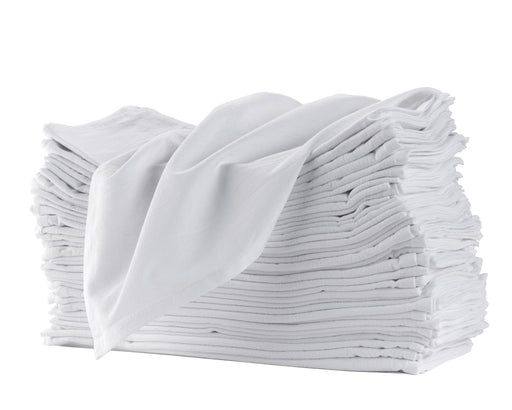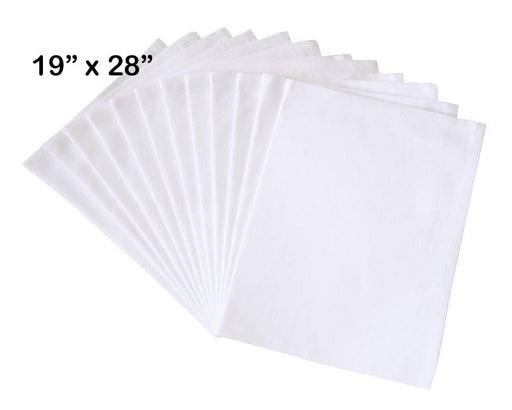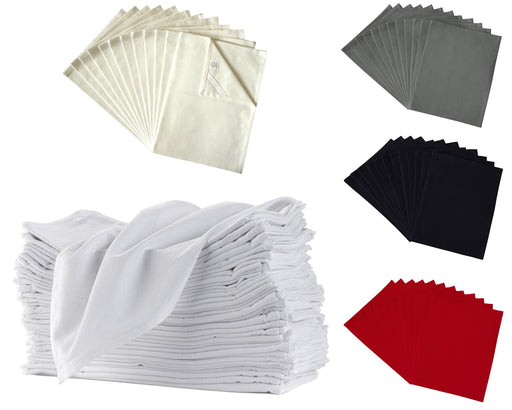Continental U.S. only.
Continental U.S. only.
Decorating your very own Halloween kitchen towel is a delightful way to bring the holiday festivities into your home. From creative and intricate embroidery designs to classic applique pumpkins, there are a variety of options available to make unique and festive decorations that will last for years. Fabric borders, fabric paint, permanent markers, and tie-dye can all be used to personalize a plain flour sack towel into a holiday kitchen towel.

As the fall season settles in and the holidays approach, crafting spooky designs becomes more popular. Possibilities for projects are endless and range all the way from homemade candles to homespun wool socks to wine racks. Somewhere in between, long-forgotten novelties with unlimited uses… are flour sack tea towels.
Let’s dive right in for some Halloween-inspired kitchen towel ideas that you can get crafty with this season!
Get Halloween ready with a do-it-yourself decorative kitchen towel! You may want to embroider your own spooky design onto your tea towel, or you could make use of our tea towel printing service if you see a digital design that you like the look of.
Digital design ideas for your kitchen tea towels may be a spooky monogram, a digital creation you have made yourself, or a graphic that you like the look of online, or one you may wish to scan onto your computer and then print onto your dish towel.

We are just as excited as you are for the Halloween season, and have come up with some creepy ideas for your Halloween-inspired tea towels below.
There are so many! It would be great if we could see your own spooky creations on our very own flour sack dish towels when you've done them! You can do this by leaving us a review on our tea towel printing page here!
Flour sack kitchen dish towels come in handy for all sorts of things, particularly around the holidays. Predictably, they excel at their traditional use; they do an excellent job drying dishes and servicing spills around the kitchen.
Gatherings that are often popular around the holiday season allow many people to admire your spooky decor and dish towels during visits. Flour sack kitchen dish towels make wonderful, practical and decorative gifts for all occasions including birthdays, housewarmings, Christmas, and as thank-you acknowledgements for invitations to dinner parties from hosts and hostesses. Imagine arriving at your next potluck with a couple of flour sack kitchen towels in hand. The individuals receiving them would understand that not only did you appreciate their invitation, but you cared enough to craft something especially spooky for them.

Festive flour sack towels can be glimpsed at craft fairs all over the country throughout fall and the holiday season. Around October, they sport images of pumpkins, cute slogans, black cats, ghosts, bats, and more. Halloween colors of orange, black, purple, and silver pop against the traditional white backgrounds to create a truly festive effect.
Later in the holiday season, Jack-O-Lanterns fade to turkeys and eventually to Christmas trees, elves, angels, and Santa Claus faces. Truly, these towels allow for an unlimited flow of creativity and innovation. Adaptable to any occasion, they are a perfect project all year long.
Flour sack kitchen towels can be bought here at Mary's Kitchen Towels as a pack of 12 for as little as $27.99 or you can buy them in bulk to save money if you're a regular crafter or shop owner. This way, they can be custom-ordered and processed on demand. Making them even more novel, sellers can add their own signature touches and symbols.
Our flour sack towels can even be purchased as part of growing collections, similar to the collector patterns available in their original heyday. Additionally, these kitchen towels make great activities for DIY projects and gifts. Lazy Saturdays turn into productivity and innovation with a little fabric paint. Easy and soft enough for little fingers to manipulate, they can even be great options for kids to decorate as presents for peers, teachers, and family members. Truly, these items are the definition of multipurpose.
SHOP PERSONALIZED HALLOWEEN TEA TOWELS NOW
Once you’ve determined how you’d like to use your blank flour sack towels, you’ve arrived at the fun part. There are a plethora of different ways to decorate these kitchen towels, each more unique than the next. Applique, fabric paint, embroidery, tie-dye, fabric borders, and permanent markers are just a few ideas to inspire your creativity.
Applique
Applique is a process of stitching pieces of fabric onto a larger piece of fabric to form an image. Appliqueing pictures of pumpkins, bats, candy corn, black cats, ghosts, witches, or jack-o-lanterns onto 100% cotton flour sack towels can be wonderful Halloween project ideas. Though maybe not ideal for kids, this sort of project provides a meditative effect to experienced applique crafters. The stitching serves as a repetitive motion that not only produces a pleasing image but quiets the brain.
Embroidery
Embroidery means using a special kind of thread and needle to create pictures with stitches on flour sack material. With traditional white backgrounds, white flour sack towels allow all sorts of Halloween colors to pop. Patterns are available online for direct duplication, or once again, creativity can reign. It can be fun to let innovation play with an art that is stereotypically organized and fairly rigid. Embroidered flour sack towels are one of the most popular kinds and can be found for sale on a variety of crafting sites.
Fabric Borders
Applying fabric borders is another way to spruce up plain flour sack towels. Festive Halloween patterned cloth can be purchased at any craft store and cut into wide or skinny strips to act as a towel border. Borders can be sewn onto towels by either hand or machine, and presto: newly decorated flour sack towels that exist in no other household.
Fabric Paint
Fabric paint is another great option for decorating flour sack towels and absolutely serves as a possibility for a younger group of crafters. With less dexterity involved, little fingers are able to utilize different colors of paint to create designs of their choice. Paint may be squeezed onto a smooth surface (like a paper plate) and utilized with brushes or q-tips for easier access with painting. Halloween designs don’t stop at tradition; encourage young crafters to let their imaginations run wild with possibility.
Permanent Markers
Permanent markers can be a great alternative to fabric paint. The trade-off is less mess for longer lasting mess. While markers guarantee that paint won’t end up in anyone’s hair, they do offer the possibility of crafting remnants long after the project is over. From a more technical standpoint, they do offer a little more capacity for detail and an easier time forming script, if lettering is part of your flour sack towel design.
Tie-Dye
Tie-dyeing flour sack towels with orange and black serve as a new way to decorate for the Halloween season. Another great option for kids, this method accommodates limited dexterity quite well. Towels are soaked in white vinegar, twisted into a design, and held in place with rubber bands. Then, they are dipped into dye and left to sit for twenty-four hours. Often, it is helpful to package wet, dye-ridden towels in individual plastic bags while they sit. After a day, the towels can be rinsed until water runs clear. Ultimately they are run through the clothes washing machine without soap and dried. The heat from the dryer helps to set the ink so that it won’t transfer to any other surface. You wouldn’t want your counter dyed with Halloween colors, as festive as they are.

Beyond methods for designing towels, there are specific examples of finished, Halloween-inspired pieces that may spark your innovation and creativity.
Redwork Country Kitchen uses embroidery thread in either one color or multiple to craft a festive, plump pumpkin complete with foliage or flowers, depending on your preference. They sell their design online, but they also serve as a starting point for creating your own.
The blog Uncommon Designs features another variation on an applique pumpkin that combines a brown stem of tiny polka dots and an orange, floral pumpkin with an actual, green, three-dimensional bow. A black rick-rack border completes the look.
Lastly, a pumpkin spice flour sack towel on ShopSwell features a look achievable with fabric paint. Font that wishes the audience “Happy Pumpkin Spice Season” is cheery and bright amidst the Halloween season.
Halloween-inspired flour sack kitchen towels are a versatile DIY crafting project for the fall season. With historical significance, a variety of uses, options for decoration, and inspiration aplenty, they ensure that crafters have something to smile about with their handmade pieces during the holidays, and don't forget that they are a washable cleaning cloth!
Whether you choose to indulge in designing your own Halloween decorative towel or wait until Thanksgiving or Christmas, holiday-decorated kitchen towels will be a hit through all of the holidays and into the new year. Check out a craft fair, surf some crafting sites, or visit a local craft store to get started decorating your own flour sack towels this fall holiday season.
Our customers are always happy to choose us for plain flour sack towel craft supplies, always leaving us four-star and five-star reviews. We pride ourselves in being able to provide the lowest price for crafters in search of plain flour sack dish towels, and our towels remain at a regular price. So what are you waiting for? Get those dish towels in your basket today before we run out ahead of the busy festive season!

If you need red, gray, blue or black color please click here. ★ Multipurpose, available white or natural colors (unbleached), matching, wholesale ...
View full details
Custom Printed Flour Sack Towels ★ Current Production Time: 3–4 Weeks WHOLESALE | RESELLERS | DESIGNERS ✅ Everyone is welcome to order! If you'r...
View full details
100% Cotton, comes in white (bleached) and natural (unbleached) color A uniform 19" x 28" rectangle, 130 thread count, flour sack napkins hemmed...
View full details
100% Cotton A uniform 27" x 27" square, 130 thread count, 3 oz each heavyweight flour sack dish towels and hemmed on all sides A corner loop for...
View full details
Attention Re-sellers, Wholesalers, and Designers: If you need to order more than 100 pieces, please contact us for our special wholesale prices. Pr...
View full details